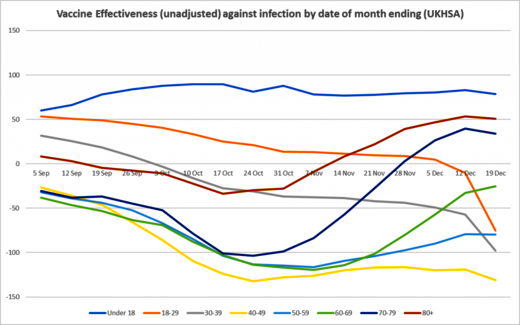The latest Vaccine Surveillance report from the UKHSA shows a sharp drop in unadjusted vaccine effectiveness against infection (calculated from the raw infection rate data) in 18-29 year-olds, down to minus-75% in the month ending December 19th, from minus-10% the previous week.
The Daily Sceptic
Fri, 24 Dec 2021 © UKHSA

Omicron slices through vaccine protection as booster effect starts to wear off
Unadjusted vaccine effectiveness fell in all age groups this week, particularly sharply in 30-39 year-olds, where it hit minus-98%. In 40-49 year-olds it fell to minus-131%. Negative vaccine effectiveness means the vaccinated are more likely to be infected than the unvaccinated. A vaccine effectiveness of minus-100% means the vaccinated are twice as likely to be infected as the unvaccinated.

Hospitalization statistics
With Omicron infections particularly prevalent in the young and the vaccinated,
this drop is likely to be the impact of Omicron, combined with a waning of vaccine efficacy. The high relative rates of infection in the vaccinated compared to the unvaccinated undermine any argument for vaccine passports or mandates that depend on the idea that the vaccinated are less likely to be infected or pass on the virus. If anything, it’s the vaccinated who are a higher transmission risk to the unvaccinated rather than vice-versa.
[Martin comments: Memorise this passage, copy and paste it, use it in any debate you have with pro-vaxxers.]

Unadjusted vaccine effectiveness against hospitalisation and death continues to hold at a high level on this data, and has even increased in recent weeks in line with what is presumably a booster effect – though a drop in vaccine effectiveness against hospitalisation in 18-29 year-olds this week may portend a coming shift.

Source date for charts

Get your copy from our Online Store or your local book and magazine retailer
Australian Retail Locations » Uncensored Publications Limited
New Zealand Retail Locations » Uncensored Publications Limited
As censorship heats up and free thought becomes an increasingly rare commodity, we appeal to our readers to support our efforts to reach people with information now being censored elsewhere. In the last few years, Uncensored has itself been censored, removed from the shelves of two of our biggest NZ retailers – Countdown Supermarkets and Whitcoulls Bookstores – accounting for 74% of our total NZ sales.
You can help keep the Free Press alive by subscribing and/or gifting a subscription to your friends and relatives.








